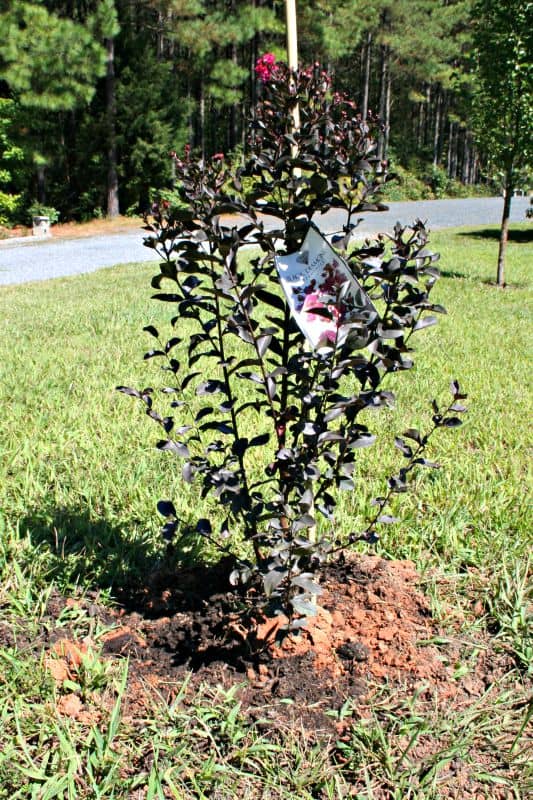A short while ago, I wrote about the new Black Diamond series of crapemyrtles. I emailed the PR director for the grower and asked for permission to reprint photos from their press kit, which she granted to me. She also asked if I’d like a sample tree. Sure, why not. Little did I know I’d fall in love with the Black Diamond crapemyrtle!
I love crapemyrtles, but the Black Diamond crapemyrtle has far exceeded my expectations. It arrived on Friday, and we planted it on Sunday. The container-grown crapemyrtle had a very healthy root system and I hope it takes to its new location along my driveway.
This new series of crapemyrtle promises almost continual blooms from July until the first frost. I liked the foliage; a dark green, with a hint of black. The flowers are a rich shade of magenta. The color on this one is called “Mystic Magenta” and it appears to be a vibrant, dark magenta shade.
The Black Diamond crapemyrtle series looks like a great new plant to add to your garden. For more information, see the grower’s website. The plants are available for purchase at Lowe’s, Home Depot, and from your favorite nursery and garden center. I received a free sample from the company as part of their public relations outreach. My review and comments are fair and honest. I plan to return to this topic next year and let my readers know how this tree is growing!
How to Plant Crapemyrtle
It’s easy to learn how to plant crapemyrtle. Most crapemyrtle, including the Black Diamond series, are container-grown. This means that they are purchased in a pot. A tree or shrub grown in a container is planted very similarly to perennials and other flowers you buy and plant in a container.
- Choose the location for your crapemyrtle. The Black Diamond series grows to about 10 to 12 feet tall and about six feet wide, but others have different mature heights and widths. Know how big your tree will get and plan accordingly – don’t plant it too close to power lines, your home, or where it will get in the way of traffic.
- Crapemyrtles need full sun to bloom beautifully. Too much shade can reduce the blooms or cause the crapemyrtle not to bloom at all. Consider the amount of light the tree will receive in the area you wish to plant it.
- Before digging, KNOW WHERE YOUR POWER LINES ARE. If you’re not sure, call the utilities company. Also know where underground sprinklers and other buried items are located. You don’t want to accidentally dig them up!
- Using a spade or shovel (or in our case, a pick axe to break through the clay), dig a hole just slightly deeper than the pot and slightly wide. Place the plant, pot and all, into the hole. The soil, when it’s pushed around the tree, should reach the same depth as the plant was grown in the pot. Don’t plant it any higher or deeper – it won’t help the plant.
- Add and mix compost into the soil if you wish.
- To remove the container-grown crapemyrtle from the pot, grasp it gently by the stem or branches. Tap on the outside of the pot and the base to loosen the soil around the plant’s roots. It should slip easily out of the pot.
- Place it into the planting hole.
- Fill in the soil around the plant.
- Tamp it down – press it with your hands or gently use your shoe to firm down the soil.
- Water well…and by ‘water well’ I mean let the water run for a good minute. Give your new planted crapemyrtle a good drink of water and water it daily until it is established.
For more information on crapemyrtles, please see:







So it looks like it’s been almost a year since you put this Crape Myrtle in the ground. Do you have anything to report on how well it’s done? I live in central Ohio and found one of these at a big box hardware store this weekend. I haven’t planted it yet, but it seems like I might have some winter trouble here in zone 6.
Great question, Stephen. This particular crape myrtle is alive and well, but hasn’t grown much. Some of it looks like deer damage, some maybe cold damage. It’s not blooming yet but my others aren’t blooming yet either. We shall see. As for zone 6, I had trouble with crepe myrtle in New York state, which is also zone 6. It grew but didn’t bloom. It was more in the shade, so that may have been part of the problem. I’d look into the varieties offered at your local stores and see what their cold tolerance is. It’s always a guess with crepe myrtles, but if you’re willing to gamble on them a bit, the rewards can justify the risk. Good luck!